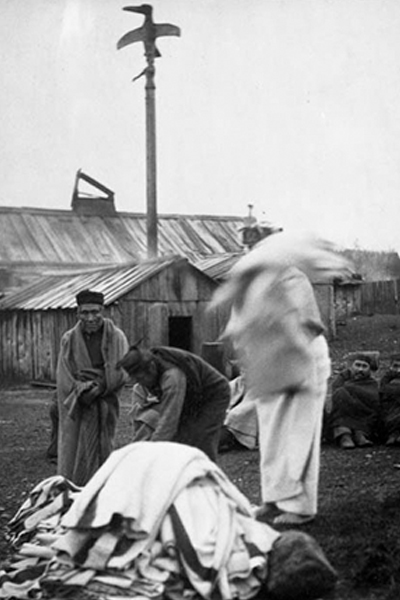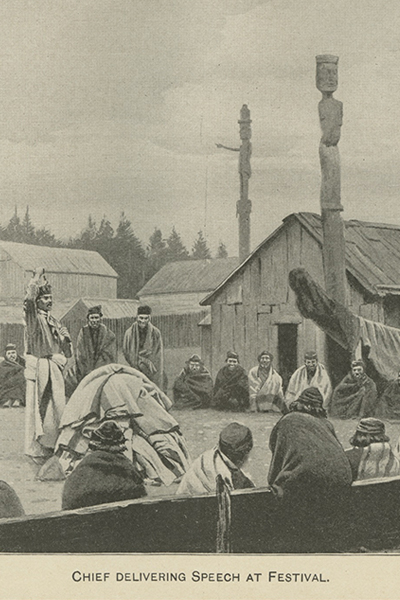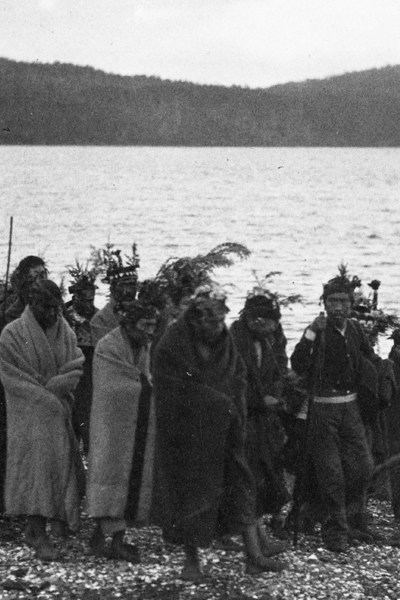CHAPTER V: 1894 FORT RUPERT
Whose “Cannibal” Masks?
The Challenge of Cultural Diffusion
Mask
Unknown maker, Heiltsuk
Wood, pigment, hide, fur, string
11 1/4 x 21 1/4 x 9 in. (28.5 x 54 x 23 cm)
Collected by Franz Boas in 1894
American Museum of Natural History, 16/963
Mask
Unknown maker, Nuxalk or Heiltsuk
Wood, pigment, hide
8 5/8 x 16 3/4 x 9 1/4 in. (22 x 42.7 x 23.5 cm)
Collected by Franz Boas in 1896
American Museum of Natural History, 16/1102
No Boas Image or Hunt notes
The headpiece on the left, which is Heiltsuk in style, has the flat mouth and hooked projection of supernatural bird masks used in the Hamat̕sa (called Tanis in Heiltsuk). Dancers wear the mask on the forehead at an upward angle, and snap the mouth with a hidden string mechanism.
The similar headpiece on the right features dashes of paint seen on other Heiltsuk pieces. However, Franz Boas attributed it to the Nuxalk, a neighboring group. This one is not rigged to be worn on the head, nor animated via strings. It may have been held at the chest in the Nuxalk Elaxotla (Cannibal Dance).
Franz Boas obtained these two masks around the time of his 1894 fieldwork in the Kwagu’ł village of Tsaxis (Fort Rupert). The masks share dark brown and red coloration, flat mouths, flaring nostrils, and recurved beaks or snouts. Boas was drawn to them because they resembled hamsamł (“Crooked Beak”) masks associated with the Kwakwaka’wakw Hamat̕sa or “Cannibal Dance,” which he initially saw performed in Berlin in 1885 (Fig. 1) and in Chicago in 1893, and then first experienced in situ in Fort Rupert.1 Boas likely purchased the mask on the left (AMNH 16/963) from curio dealer John J. Hart in Victoria in September 1894, before he journeyed to Fort Rupert.2 He bought the slightly smaller mask on the right (AMNH 16/1102) from Victoria dealer Samuel Kirschberg in 1896 after becoming a curator for the American Museum of Natural History.3
Fig. 1. Nuxalk men perform in “Cannibal” bird masks in Berlin in 1886. The dancer at center front wears a Kwakwaka’wakw “Crooked Beak” version (FMNH 19304). Boas saw this group in Berlin, which inspired his attention to Northwest Coast cultures and particularly the Hamat̕sa.
Photo by Carl Gunther. “City of Vancouver Archives,” AM54-S4-: In P30, Major James Skitt Matthews.
During and after his 1894 trip, Boas was eager to collect pieces from different groups that practice similar cannibal-themed ceremonies.4 He aimed to use such objects, oral histories, and observational data to trace the historical movement of Cannibal Dance forms and ideas between communities, a topic treated extensively in the 1897 book. Boas may have been particularly interested in the first mask because it is Heiltsuk in style. This group, whose territory is to the north of the Kwakwaka’wakw, transferred many Hamat̕sa prerogatives to the Kwagu’ł and other bands through marriage and war.5 These findings supported Boas’s theory of a northern origin for the Cannibal Dances.
In the book, Boas includes photographs of the first mask in Plate 30. The caption associates it with Baxwbakwalanuxwsiwe’, the man-eating spirit that possesses Kwakwaka’wakw Hamat̕sa (as well as Heiltsuk Tanis) initiates.6 However, Boas’s description for Plate 30 mistakenly includes the length and catalog number of the second, smaller mask. In the AMNH catalog, Boas listed the smaller mask as belonging to the Nuxalk, the eastern neighbors of the Heiltsuk.
The mistake in the bookplate caption underscores the complexities of diffusion that Boas sought to reconstruct. Heiltsuk and Nuxalk Cannibal Dance ceremonies, for example, differ in fundamental ways even though they use similar-looking regalia. Heiltsuk “Crooked Beak” masks represent the hungry supernatural bird attendants of Baxwbakwalanuxwsiwe’, and are worn high on the forehead, as with Kwakwaka’wakw Hamat̕sa masks (see Fig. 1). The dancer clacks the mouth open and shut using a string mechanism, which the Heiltsuk mask on the left features. The Nuxalk, on the other hand, use bird carvings with curved beaks as salhpstas, a type of regalia held at the initiate’s abdomen, not worn on the forehead.7 In ceremony, a hinged jaw allows a dramatic simulation of the cannibalistic spirit vomiting consumed flesh.8
It is not clear whether Kirschberg knew that the smaller mask came from the Nuxalk or if Boas proposed the attribution alone. If it was indeed used by the Nuxalk, it may have served as a salhpsta, as it lacks the rigging for a dancer to secure it to the head while clacking the mouth.9 It also shares some features with a Nuxalk salhpsta that Boas had collected in 1886 and published in the 1897 volume (Fig. 2).
Fig. 2. Boas identified this mask (NMNH E129509-0), which has a moveable jaw, as a Nuxalk salhpsta. He may have obtained it in Victoria in 1886 from a Nuxalk man who had been in the group in Germany the year prior. Boas 1897:650 (Fig. 200).
Intriguingly, the smaller mask on the right also has some stylistic attributes that are more commonly Heiltsuk, which may help explain why Boas confused the two masks; in research for this exhibition, consultants from the Nuxalk, Heiltsuk, and Kwakwaka’wakw noted the shape of the mask’s eyes and planes as well as the parallel dashes on the brows and nasal bridge.10 Since Nuxalk and Heiltsuk people have long been connected through co-residence and intermarriage, and have hired each others’ carvers, the smaller mask could represent a transcultural object.11 Without firm provenance for the two masks, it is difficult to assert exactly what they are or how they were used.
Hunt’s 1920s revisions to the 1897 bookplate raise even further questions. Hunt asserts that the pictured mask is a galukwiwe’, which means “Crooked Beak” in Kwak̓wala (Fig. 3).12 He also states that it “belong” (sic) to the Wuikinuxv, a group centrally located between the Nuxalk, Heiltsuk, and Kwakwaka’wakw. Oral histories document both the Heiltsuk and Wuikinuxv as originators of the Cannibal Dance among the Kwakwaka’wakw. Hunt’s comment is unclear; did he mean that this particular mask had once belonged to the Wuikinuxv, or only that rights to such masks trace to these northern neighbors? In the ambiguities involved in these two Central Coast objects, we can see both Boas and Hunt working out problems of transfer and adaptation that still occupy researchers and community members to this day.
Fig. 3. “Crooked Beak” supernatural bird mask made by renowned 20th-century Kwakwaka’wakw artist Willie Seaweed, who elaborated on the more restrained carving and painting styles of the 19th century. Image RBCM 16440 courtesy of the Royal BC Museum and Archives.
By Laura Allen
PAGES IN THIS CHAPTER
- Haberland, “Nine Bella Coolas in Germany.”
- “Accession File 1895-4.” Archives, Division of Anthropology, American Museum of Natural History, New York, NY.
- “Accession File 1896-42.” Archives, Division of Anthropology, American Museum of Natural History, New York, NY. The mask on the right was part of a shipment that Kirschberg sent to New York in hopes of securing higher prices for his stock. After the steamer caught on fire, the lot was sold to pay for the ship salvage. Boas purchased 177 items for AMNH at a bargain price.
- For example, Boas obtained two more Hamat̕sa masks while in Fort Rupert in 1894, which he then published: Boas, The Social Organization, Plate 31 (NMNH E169105) and Fig. 78 (NMNH E169106).
- Boas, The Social Organization, 425–427, 664; Boas, Kwakiutl Ethnography, 258.
- In the bookplate, Boas captioned 16/963 as “representing” Baxwbakwalanuxwsiwe’. However, most experts assert that Hamat̕sa masks never depict this spirit directly; rather, the mask can be considered as belonging to the spirit by depicting one of his supernatural bird attendants. Boas may have simply misunderstood Hunt’s frequent identifications of such items as “the mask of Baxwbakwalanuxwsiwe’.”
- Salhpstas, which depict various birds and mammals, are often made “ugly” on purpose, with sharp teeth and roughly applied fur, feathers, or skin (Stott, Bella Coola Ceremony and Art, 68). The appearance signifies a dead, rotting creature (Clyde Tallio, personal communication). The mask on the right is akin to more polished Nuxalk masks that Boas identified as salhpstas, such as the one in Fig. 2 here and AMNH 16/1463 (see Boas, Mythology of the Bella Coola Indians, 119–20).
- McIlwraith, The Bella Coola Indians II, 71, 78–79; Clyde Tallio, personal communication.
- Further circumstantial evidence for the smaller mask being a salhpsta is the nail holes on the back, where a cloth cover may have been attached to conceal the “vomit” maneuvers (Clyde Tallio, personal communication). However, white residue on the mask’s interior complicates the picture. The residue bears chemical traces of titanium, possibly from a user’s face paint, suggesting it may have been worn on the forehead at some point.
- For example, see Heiltsuk masks with similar stylistic features: National Museum of the American Indian 5/9833, Royal Ontario Museum 27875, and National Museum of Natural History E20576.
- Hilton, “Haihais, Bella Bella, and Ooweekeno,” 314; Black, Bella Bella 23, 84–89; Clyde Tallio, personal communication. The smaller mask, while not entirely outside a Nuxalk canon, may have been Heiltsuk-made but used as a salhpsta in the Nuxalk Cannibal Dance through a family prerogative. Alternate scenarios are that it was used by the Heiltsuk with a modified rigging style, or that it was carved by someone with intercultural ancestry or training.
- The fact that 16/963 has black bear fur instead of cedar bark like other Cannibal bird masks is also interesting. While black bear fur is featured in some Cannibal Dance regalia, its usage here suggests yet another alternate scenario: that the mask represents a creature other than a bird and was used in a different dance (Harvey Humchitt and Trevor Isaac, personal communication).











